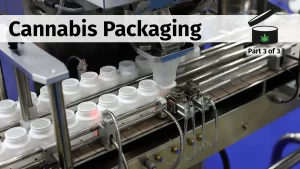
(Editor’s note: This is the third installment in a three-part series on marijuana and hemp packaging solutions. Part 2 is available here.)
Emerging technologies and shifts in consumer buying habits since the coronavirus pandemic are shaking up the consumer packaged goods (CPG) sector.
Packaging innovations like artificial intelligence (AI), remote analytics, digitization and even augmented reality are creating a new level of company efficiencies and consumer experience.
But will these innovations cross over into cannabis?
Not all packaging innovations make sense for cannabis companies, which “typically (are) not looking for the same speeds and automation control” in packaging that other CPG sectors are, said Jim Chrzan, vice president of content brand development at Packaging World magazine.
That said, some trends are worth watching.
1. Contract packaging
The cannabis sector is seeing an emerging contract packaging, or co-packing, service. It follows in the footsteps of the CPG sector.
Contract packaging in the CPG sector saw significant growth during the coronavirus pandemic, reflecting a change in consumer buying habits and labor shortages.
Contract packaging is an option for a company looking to reduce packaging labor but not ready to invest in the necessary equipment, Chrzan said.
In other cases, as companies mature they may find it makes more sense to contract out those services while they concentrate on the aspects of their business they do best.
Patrick Wlaznak, the founder of Washington state-based Soulshine Cannabis, started three years ago offering co-packing services for other cannabis companies. But he ended up suspending that service and now does just the opposite – contracting out some of his processing and packaging needs to co-packers.
“It’s a maturity issue. These legacy companies like myself get tired of doing everything,” Wlaznak said. “You try to find somebody else who has a better machine or a better system; they can make more joints, or they can process and package your materials faster and cheaper than you can.”
2. Digitization and AI
Digitization has come to the CPG packaging sector, bringing the power of analytics and AI to create packaging automation efficiencies and improve product traceability.
Cannabis has yet to see a similar level of packaging automation analytics though it offers obvious benefits, said Amelia Dishion, senior vice president of cannabis sales for ActionPac Scales and Automation.
“I feel like real streamlined automation of data is what people need to be looking at,” Dishion said.
Many packaging equipment manufacturers provide data collection as part of their machine functions, and cannabis manufacturers are collecting and reporting data to meet state cannabis regulations.
But the cannabis sector doesn’t yet have industry software solutions that let them automatically collect, organize and analyze their packaging and production performance, Dishion said.
“Our scale is retaining all kinds of information. Every single cycle weight, how many passes, how many rejects, how many products have been put through the machine, who was running the machine. It’s all this production data,” Dishion said.
“At (a company like) See’s Candies, that data is then being sent to and integrated with their programs.”
3. Sustainability
Sustainability is a big buzzword in CPG packaging.
CPG brands are responding to the consumer outcry over everything from landfill waste to the impact of plastic packaging on aquatic ecosystems, and bringing a renewed emphasis on recycled and biodegradable packaging options, according to a 2020 McKinsey report.
Though sustainable packaging has been slow to gain a foothold in cannabis, manufacturers are starting to feel the same pressure to adopt packaging that’s better for the environment.
Expect that trend to continue, predicts Luke Millspaugh, project manager for sustainability at Contempo Specialty Packaging, a Rhode Island company producing sustainable packaging options for the cannabis industry.
“It’s a major part of my generation,” Millspaugh said, pointing to the recent COP26 climate summit in Glasgow, Scotland, and news surrounding climate change and environmental damage caused by consumerism.
“Now that we’re getting out into the workforce and getting our own money, we’re demanding companies make these changes,” Millspaugh said. ”That’s going to progress more as we come into these next years.”
4. Faster, more efficient packaging technologies
Speed and efficiency is the goal of CPG packaging automation. Although cannabis manufacturers don’t require the same level of performance that other sectors do, efficiency is still crucial to automation practices.
Expect to see more efficient technology as automation companies continue to customize for cannabis needs.
In some cases, it may be simply a matter of figuring out how to adapt commonly used automation equipment to the unique needs of cannabis, Dishion said.
Vertical bagging is one example – a fast, user-friendly and efficient packaging process using thin, flexible packaging for products such as potato chips. The bag is formed around the product as the product falls through a tube, which is why you get air in potato chip bags, Dishion said.
But vertical bagging has yet to come to cannabis in a big way. Cannabis packaging regulations require a thicker film of material than that used in CPG vertical bagging machines, she said.
But if rules were changed or the machines could be adapted for cannabis regulations so vertical baggers could be used for packaging cannabis items like single-use grams or pre-rolls, “that would be revolutionary,” Dishion said.
“A radial scale integrated with a vertical bagger isn’t just the fastest configuration. It’s also the easiest to use.”
Download the new “MJBizDaily Buyers Guide: Packaging Automation” to read more about packaging automation trends and considerations for planning for efficiency and applying automation innovations to your business.

